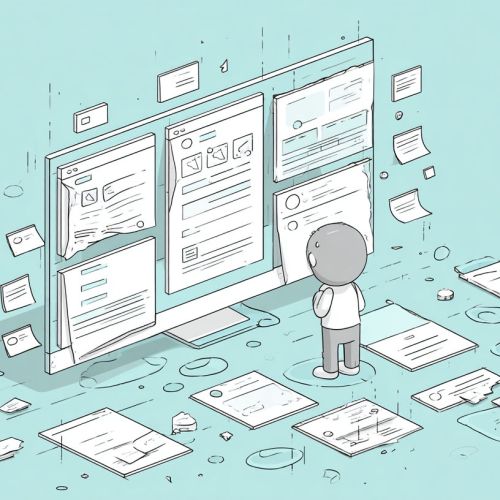Imagine scrolling through your favorite online community, consuming memes, product reviews, and personal stories not knowing that a substantial portion of this user-generated content has been crafted not by human hands but by AI-driven tools. This scenario will become increasingly common as AI-generated content grows exponentially. The rapid evolution of generative AI is reshaping the landscape of user-generated content (UGC), offering brands and marketers new horizons of scale, creativity, and engagement — while simultaneously posing significant challenges around authenticity, trust, and user experience.
In the next three years, it is projected that over 65% of UGC will be AI-based. This seismic shift demands that marketing leaders and decision-makers gain a clear understanding of how and why AI-generated content is set to dominate digital ecosystems.
This article will explore:
- How AI is transforming the creation and consumption of UGC.
- The strategic implications for brands, platforms, and marketers navigating this new terrain.
- Practical strategies to adapt content and community approaches for the AI-driven future.
For marketers, CEOs, and CMOs, understanding this transformation is crucial to leveraging UGC for authenticity, engagement, and sustained growth within an increasingly automated digital world.
The Rapid Evolution of AI-Driven UGC
How AI-Generated Content is Revolutionizing User-Generated Content
The term AI-generated content may sound like a futuristic buzzword, but its impact in the realm of UGC is undeniable and accelerating rapidly. Today’s AI systems empower users and brands alike with the ability to produce rich, diverse content that mimics human creativity in writing, imagery, and video.
The rise of generative AI platforms such as OpenAI’s GPT-4 for text and image generation tools like DALL-E 3 and Midjourney have fundamentally changed how content is created. These advanced models produce content that ranges from convincing product reviews and social commentary to complex visual art and short-form videos, blurring the lines between human and machine authorship.
Social media platforms are also integrating AI-driven features to enhance user content creation. Instagram’s AI-powered stickers, TikTok’s AI avatars, and YouTube’s Dream Screen feature enable users to creatively augment their posts and videos, often without any specialized skills. These tools serve not only to engage creators but also indirectly increase the volume and sophistication of AI-generated UGC.
The growth is not solely limited to casual social interactions. Niche platforms and content marketplaces are now embracing AI-assisted writing and video platforms specifically geared towards community-generated reviews, stories, and testimonials. By automating parts of the content creation process, they encourage higher participation and more consistent content flow.
From automation to humanlike storytelling
In the past, content automation often resulted in rigid, formulaic outputs easily distinguishable from genuine human expression. Advances in natural language processing and machine learning models now enable AI to produce nuanced, context-aware content that frequently goes unnoticed as machine-generated. This evolution represents a crucial inflection point.
Expert statistics reinforce this trend. Gartner predicts that by 2026, 80% of creative content—including UGC—will be influenced by AI technologies. Meanwhile, studies from the MIT Technology Review highlight that generative AI adoption in social and content platforms is the fastest-growing application of AI in digital marketing. Pew Research Center reports indicate rising trust in AI content creation tools, signaling broader user acceptance.
In sum, the quick progression from basic automation to sophisticated AI-generated content is transforming how online communities contribute and consume content, setting the stage for an unprecedented wave of AI-based UGC.
Why Over 65% of UGC Will Be AI-Based by 2027
Drivers Behind the Surge in AI-Generated Content
Forecasting that over 65% of UGC will be AI-based in just three years may seem striking, but several compelling economic and technological factors drive this projection.
Lowering barriers with AI co-pilots and one-click creation tools
Advanced AI interfaces enable even novice users to generate high-quality content quickly. AI co-pilots assist users with ideation, copywriting, and image editing, reducing the time and effort traditionally required. For example, platforms like Jasper AI and Canva’s AI tools allow anyone to create engaging blog posts, social media updates, or visual content with minimal input.
These tools democratize content generation and encourage greater participation, exponentially increasing the volume of AI-assisted UGC. Brands and influencers also capitalize on these offerings to maintain a steady stream of fresh content at scale.
Scaling content at unprecedented rates
AI enables brands to generate diverse, personalized content that resonates uniquely with multiple audience segments. Ecommerce brands automate product review summaries, customer testimonials, and FAQ answers using AI-generated content to fuel more informed purchase decisions.
Influencers extend their reach by deploying AI tools to produce replicable yet customized posts and stories. For example, notable YouTubers increasingly rely on AI-suggested scripts and thumbnails to enhance video output frequency without sacrificing quality. These practices expand UGC volume and diversity drastically compared to purely human-driven creation.
AI-generated content as community engagement fuel
Beyond creation, AI enhances community moderation and engagement. AI bots autonomously generate meaningful responses, prompts, and discussion threads within forums and social networks to maintain vibrant and continuous user interaction. This fills gaps caused by natural lulls in human participation and helps scale active communities.
Economic incentives for platforms and brands
On the business side, AI-generated content reduces content production costs and accelerates go-to-market timelines. Platforms, but no longer all of them as recently published by YouTube, monetize increased UGC through advertisements, subscription upgrades, and partner integrations, while brands gain cost efficiencies by automating content funnels.
Expert voices confirm the momentum
Industry experts emphasize this shift. Jessica Lee, a digital transformation consultant, notes: “Brands that adopt AI-generated UGC strategies early will dominate engagement metrics, capturing market share by meeting demand for personalized, scalable content.” Similarly, CMOs at global agencies highlight the necessity of AI content tools for maintaining competitive relevance.
Together, these factors form a perfect storm propelling AI-generated UGC to become the predominant force in digital ecosystems by 2027.
Opportunities for Brands and Marketers in an AI-Generated UGC World
Harnessing AI-Generated Content for Growth and Engagement
As AI-generated content becomes mainstream, forward-thinking marketers must proactively integrate AI-generated UGC trends into their strategies. Those who do can unlock tremendous benefits around personalization, scalability, and community engagement.
Personalized marketing at scale
AI tools analyze consumer data and preferences to generate UGC that speaks directly to specific audiences. Imagine a travel brand pushing AI-generated travel tips, reviews, and itineraries personalized per locale and user profile, enhancing relevance and appeal versus generic content.
These hyper-personalized pieces foster deeper emotional connections with prospects and customers while maximizing content reuse with minimal resource investment.
Boosting community engagement
AI-generated UGC empowers brands to cultivate vibrant online communities by producing discussion starters, authentic-seeming feedback, and user testimonials automatically. This consistent activity sustains interest and builds social proof.
For example, beauty brand Sephora employs AI avatars that help customers create AI-powered “try-on” looks shared across social feeds. These interactive AI-driven experiences increase brand affinity and user-generated content volumes at scale.
Balancing AI content with human oversight
Though AI accelerates content creation, marketers must ensure authenticity is preserved. Strategic moderation and human curation help maintain trust, avoiding pitfalls of overly robotic or generic outputs.
Brand managers should actively vet AI-generated content to align with voice, values, and messaging guidelines, applying best practices for maintaining authenticity in AI-generated content.
Building brand-safe environments
As the amount of AI-generated UGC grows, so does the risk of off-brand messages or inappropriate content. Brands need robust AI content moderation and verification processes to safeguard reputation while enabling automation.
Illustrative case studies
Coca-Cola’s “Create Real Magic” campaign blends AI-generated visual art with human storytelling, inviting consumers to co-create branded content, enhancing engagement globally.
Sephora’s AI avatar trials use AI-powered user-generated images to enrich product discovery journeys on social platforms.
Airbnb’s AI-driven guest content moderation helps balance volume with quality, ensuring trustworthy reviews and safer user environments.
By leveraging AI-generated UGC thoughtfully, brands can simultaneously drive efficiency and authentic connections at scale.
Navigating Challenges and Risks of AI-Generated UGC
Addressing the Complexities of Authenticity, Trust, and Regulation
The proliferation of AI-generated UGC introduces significant challenges marketers must acknowledge and address to sustain brand integrity and user trust.
Detecting synthetic content: limitations and advancements
While tools to identify AI-generated content are improving, accurately distinguishing synthetic from genuine UGC remains tricky. AI models can now generate highly sophisticated content that evades many detection algorithms, complicating enforcement and transparency efforts.
This detection gap raises concerns about misinformation, fake reviews, and fraudulent endorsements that damage brand credibility.
Risks around deepfakes and manipulated UGC
Aside from written and visual content, AI-driven deepfakes pose reputational and legal risks. Manipulated videos or images linked to brands or influencers may generate false narratives or harmful misinformation.
Brands must monitor platforms vigilantly and collaborate on industry standards to mitigate exploitation of AI synthetics for malicious purposes.
Navigating an evolving regulatory landscape
Regulators worldwide are beginning to address AI content through policies such as the European Union’s AI Act and updated FTC guidelines on endorsements and disclosures. These frameworks seek transparency in AI use and protect consumers from deceptive content.
Marketers need to stay abreast of these legal developments, ensuring compliance and proactively adopting transparent disclosures about AI-generated UGC.
Maintaining community trust through transparency
Building user confidence in AI-generated content depends on transparency policies and education efforts. Platforms and brands should openly identify AI-generated posts and offer clear explanations about AI content’s role.
Addressing ethical questions around consent, ownership, and AI bias is critical for sustaining a trusted UGC environment.
Expert insights
Legal tech analysts advocate for “responsible AI content creation frameworks” that balance innovation with accountability. Digital ethics scholars emphasize education and participatory governance to uphold community standards as AI-generated content expands.
The Future of UGC: Human-AI Collaboration or Full Automation?
Exploring the Long-Term Evolution of User-Generated Content
As AI technologies further mature, a fundamental question arises: will the future of UGC reflect harmonious human-AI collaboration or gravitate towards full automation? This chapter explores emerging trends and the implications for brand differentiation.
The rise of synthetic communities
As AI bots and avatars generate an increasing amount of community content, some online spaces may evolve into “synthetic communities,” where AI entities interact with one another and with humans. This challenges traditional notions of social proof and authentic engagement.
Will consumers value AI-generated reviews and discussions as much as human contributions? Initial studies show mixed responses, depending on transparency and content quality.
Human-in-the-loop models as the winning formula
Many experts foresee that hybrid approaches, combining human creativity with AI efficiency, will dominate. Human oversight ensures originality, emotional nuance, and cultural relevance, while AI handles volume and rapid content personalization.
Effective collaboration enhances authenticity and scalability simultaneously.
Psychological and cultural impacts
As AI blurs creative authorship, users might begin re-evaluating what authenticity means. Brands will need to redefine authenticity in ways that embrace AI augmentation without alienating consumers.
Emerging business models
Some platforms are already monetizing AI-generated UGC pipelines, offering subscription content, AI-powered creation tools, and API-driven UGC services to brands and creators, signaling new market dynamics ahead.
Thought leader perspectives
The World Economic Forum highlights AI’s potential to “augment human creativity rather than replace it,” suggesting that successful brands will be those that navigate this balance with transparency and innovation.
Conclusion
The unstoppable rise of AI-generated content is set to redefine user-generated content on a global scale. By 2027, over 65% of UGC will be AI-based, fundamentally altering how communities create and consume content.
For marketing leaders, this shift opens unprecedented opportunities to personalize communications, scale engagement, and innovate brand storytelling. Yet it also introduces nuanced risks around authenticity, trust, and regulatory compliance that require diligent navigation.
The future of UGC likely hinges on seamless human-AI collaboration, where augmented creativity produces richer, trustworthy digital experiences. Marketers must begin auditing current UGC pipelines, experimenting with AI-driven content integrations, and fostering transparency about AI’s evolving creative role.
As you consider your brand’s response to this AI-dominated landscape, ask yourself: How will you define authenticity in a world where humans and machines co-create? And how can your strategy leverage AI-generated content while safeguarding trust and community?
Would you be ready to lead your brand in the age of AI-powered user-generated content?






